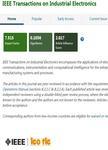版权所有:内蒙古大学图书馆 技术提供:维普资讯• 智图
内蒙古自治区呼和浩特市赛罕区大学西街235号 邮编: 010021

作者机构:Tsinghua Univ Dept Elect Engn Beijing 100084 Peoples R China
出 版 物:《IEEE TRANSACTIONS ON INDUSTRIAL ELECTRONICS》 (IEEE Trans Ind Electron)
年 卷 期:2023年第70卷第5期
页 面:4809-4819页
核心收录:
学科分类:0808[工学-电气工程] 08[工学] 0804[工学-仪器科学与技术] 0811[工学-控制科学与工程]
基 金:State Key Program of National Natural Science Foundation of China [U2034201] China Postdoctoral Science Foundation [2021M701844]
主 题:Switches Computational modeling Numerical models Sampling methods Control systems Real-time systems Delays Correction method hardware-in-the-loop (HIL) modeling and simulation of power electronics numerical method real-time (RT) simulation
摘 要:Real-time (RT) hardware-in-the-loop (HIL) simulation aims to speed up the validation process for power electronic systems (PES). The complex PESs with high switching frequency constitute some of the most challenging applications in RT-HIL. Conventional RT-HIL relies on adding extra expensive computing hardware to achieve submicrosecond step size, reducing errors caused by unavoidable sampling delays. This article proposes a CPU-based event-driven RT (EDRT) simulation framework by improving the algorithm rather than using additional hardware. The framework consists of two parts: 1) the synchronous-cycle event detection sampling method, which eliminates the delay error by detecting switching events;and 2) the discrete hybrid time-step numerical algorithm, which combines variable and fixed step-size simulation to improve the calculation efficiency and uses the ideal model to improve the modeling accuracy. The proposed framework is applied to a power electronic transformer with 24 switches and a 20 kHz switching frequency as a simulated case. Comparing the proposed simulation results with experimental results and other simulation results, the proposed EDRT framework can achieve the same numerical accuracy as the offline simulation but only requires 1/36 of the computation time. Furthermore, the hardware cost to achieve the same computational scale is reduced to 1/20 of the conventional HIL.